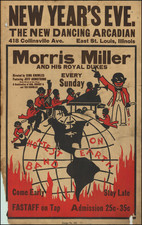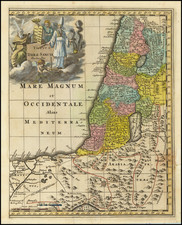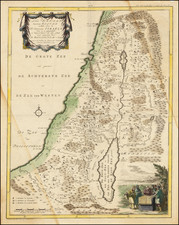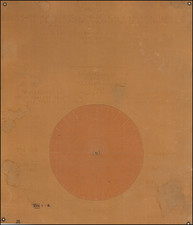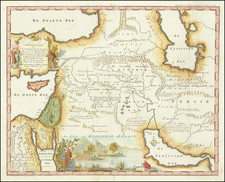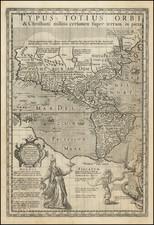Nice example of Heinrich Buenting's clover leaf map of the world, with Jerusalem at the center, based upon the T-O world map model which was prevalent prior to the 16th Century.
Europe, Africa and Asia are within the 3 clover leafs, while England, Denmark, Swedent and America lie outside the primary cirlces. The ocean includes monsters, mermaids and a large sailing vessel, likely a representation of Magellan's circumnavigation. The map is one of the most sought after of cartogrpaphic curiosities, blending a Bibilically themed presentation of the world with contemporary myths of the seas.
Heinrich Buenting was a theological commentator from Hanover. He first published his Itinerarium Sacrae Scriptura in 1581. The work is famous among collectors as one of the great compilations of thematic maps, including Europe as a Queen and Asia as Pegasus.
Shirley notes that Buenting's Itinerarium . . . "was reprinted at least 10 times in several languages" over the next 70 years and "at least two further sets of [wood] blocks were produced, in addition to normal variations in type occurring. . . " as movable type was still being inset into the wood blocks to create the text within the maps, a practice started by Conrad Swenheym, who apprenticed with Guttenberg and oversaw the 1478 Rome edition of Ptolemy's Geographia. We note the following variant editions, using this map as the model:
The present example has the word "Meridiens" outside of the bottom neat line and a solid unbroken top neat line. We note the following variant editions:
1. Broken neat line on right side of map, with Meridiens outside neatline, but overlayed on top of neatline, again causing loss of neat line.
2. Meridiens inside of neat line to the right of Africa. Many minor text variations. Mountains have a number of variations. Much larger type face used for the word America.
3. Roman numerals for pagination (IIII and V), Engeland spelled with 1 "L", Meridiens below neat line, with minor breakage to lower neat line above Meridiens, Alexandria 72, rather than "Alexandria 62" and several other number variations, significant variations on the mountains between the two plates.
4. Title and place names in Latin. pages are 22 and 23, cruder engraving style.









